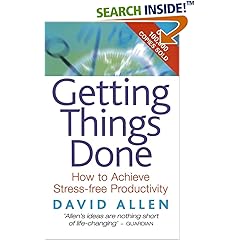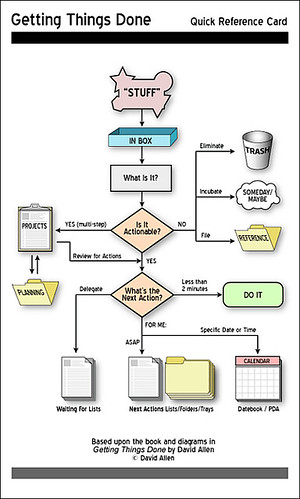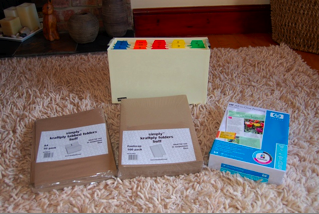Hope you are all having a productive day!
 If you are not already, now is a great time to subscribe to this blog in your favorite RSS reader so you can keep up to date with all the posts.
If you are not already, now is a great time to subscribe to this blog in your favorite RSS reader so you can keep up to date with all the posts.
One of the major improvements in my life since starting following the Getting Things Done Methodology, is the reduction of Open Loops. As we all know, Open Loops are those tasks floating around in the ether, that we should be doing, but we do not actively record.
An Open Loop is anything pulling at your attention that doesn’t belong where it is, the way it is.
Anybody who has read the Getting Things Done methodology will understand what I am talking about and if you haven’t, you don’t know what you are missing to get this area of your life under control.
You could say I am a busy guy. I am actively involved with 5 of my own companies. I have four children, a wife, and an active social life. Now, I have a LOT to get done! I also had a lot of Open Loops before I made the decision to get my life my organized. If you are anything like me. Numerous times in the day, you would remember that you had some task to do. This could be related to your business, home life, or other. It could be any random task that either just comes to you, or something you are doing jogs your memory and bang, there it is. You are at that moment presented with a task, and one that needs collecting.
Now, I have a pretty good memory and I used to try to remember these tasks in my head. Big mistake, and the start of an Open Loop. Then, the next day, or whenever, something would again jog my memory and I would be left with the same task entering my mind that needs completing. Some of these were important tasks that really did need to be collected and I, as I am sure you all, sometimes forgot things that were important.
Removing these Open Loops from your life is one major step towards getting organized and it is no surprise that a lot of the first chapter of the Getting Things Done book covers the importance of closing these Open Loops.
Now, one of the most important aspects of removing these Open Loops is to record the action/task as soon as it comes into your mind, without exception. It is the procrastination of not writing these down that make them into Open Loops. I much prefer Closed Loops!, Tasks and Actions that are recorded into a system that I trust. This is all part of the very simple GTD methodology.
The very simple way that I have embraced this, is to very simply write things down as they come to me. Now, you need some tools to do this, a pen and paper.
I had read about the Moleskine Notebooks on various sites such as 43Folders.com and thought they looked pretty cool so I went ahead and bought one from eBay. Well, I wrote a post about my thoughts on Moleskines, and must admit that I love them to bits. There is something about the quality that makes you take pride in writing, and collecting your notes into them.
I own the small pocket Moleskine notebook, as well as the large Moleskine notebook. Both of these are hardback books. Now these books are fantastic for taking into business meetings and I must admit the larger one has had a lot of use. The small notebook normally goes away on trips with me, both personal and pleasure. The problem I find with these Moleskine’s is that I cannot easily take them everywhere with me.
So, there were still times when an action came to me that needed recording and left me scrambling for a pen and paper to write it down. I have played with PagePacker, which is a pretty Cool Mac Application that allows you to print mini books full of Calendars, Lists, and also the GTD Flowchart. Luckily, I noticed that Moleskine did a range of products called “Cahier”. The Moleskine Cahier is small pocket sized book with a softback. It is slim enough, with only 64 pages, to fit into the back pocket of your trousers.
The new Moleskine Cahier [kaa yáy] Notebook Series are each offered as a set of 3 notebooks, featuring a flexible soft cover, acid-free paper and visible side stitching on the spine. The last 16 sheets of each notebook are detachable, by means of a micro-perforated edge, perfect for exchanging loose notes. Inside the back page there is a spacious pocket for notes or clippings.
Now, since buying a pack of three of these for a very reasonable £5 from eBay, I have tried to carry one with me everywhere to enable me to record my thoughts as and when they spring into my head, to remove all Open Loops from my life.
So, now I have the paper sorted out, next is the pen!
I have quite a few nice pens. Some I have bought myself and some bought for me as presents. I really like and own a few Mont Blanc pens, but the idea of carrying a £200 pen around with me doesn’t fill me with warm feelings, especially when I tell you about my Space Pen experiences!
After reading various blog posts about Fisher Space Pens, I decided to go ahead and buy one. It cost me around £20 for the Space Pen Bullet. This is a little pen that is the normal size when the cap is attached in writing mode and half size when the cap is closed. Quite cool. These use pressurized cartridges so they can write upside down, underwater, and in space, hence the name. Now I believe in GTD, but not enough to take my pen with me swimming or the next time I go on a Lunar Mission!, so that did not really bother me but one great side effect of this technology is the fact that due to the fact they are pressurized, it makes them so the ink does not leak out all over your trousers. I used to keep the Space Pen in the little coin pocket of my left jeans pocket. many a time I would reach into my pocket and pull out my shiny space pen, stand on my head and collect my thoughts into my nice Moleskine Cahier notebook!
Only problem was, after losing three pens, and having one washed in the washing machine (I blame my wife for not checking the pockets:) it became a rather expensive obsession!
So, loathed to spend another £20 on these pens, I was forced to look for an alternative, to strive to find the perfect solution for recording my thoughts, and keeping those pesky Open Loops, well and truly closed!
Do you know what?, I think I may have found the answer!
I am a golfer. I play, or try to play as much as I can. I have played since the ages of 8 and I am pretty good at it. What does Golf have to do with GTD I hear you ask?, well, I remember using some Golf Pencils when I was younger that used to clip to the golf scorecard. So, after 2 mins searching on good old eBay, I managed to find some using the search term of “golf pencil”.

I bought 100 of these pencils for around £3.50, that is around $7. So, they work out at 7 cents per pencil. In other words, I can buy 571 of these pencils for the price of one Fisher Space Pen. These pencils come with a clip on them
Because the Moleskine Cahier has only 64 pages, the clip will either clip inside the front cover of the notebook or right up to the middle of the notebook to save your page. I clip the pencil to the notebook as you can see in the image below. This then goes in my back pocket and has been there for the past two weeks.
I have travelled over a thousand miles in the car with this in my pocket and the pencil holds up just fine. You can sit on it, twist it, throw it, bend it, shake it!, and at the end of the day if you do break or lose it, you are not going to lose sleep over 7 cents!
 This little bit of simple help has changed the way that I am able to record my tasks, as the enter my head. I am no longer scrambling around trying to find a pencil, as I always have one to hand, in my back pocket, nicely attached to my pocket notebook.
This little bit of simple help has changed the way that I am able to record my tasks, as the enter my head. I am no longer scrambling around trying to find a pencil, as I always have one to hand, in my back pocket, nicely attached to my pocket notebook.
Closing my Open Loops has been the largest change that implementing GTD has brought to me. If I could say one thing to you about the Getting Things Done methodology, it would be to carry a notebook, write down the thoughts as they enter your head. It is simple, yet revolutionary. You have t get into the habit of carrying the notebook with you everywhere, pretty much as you have to wear shoes, you also have to carry your notebook,. I feel naked without mine now and it has just become a part of my daily life to carry it.
Phew, ranting over. Hope you have enhoyed this post, if you have, I would love to have a comment and please add anything you can and agree or totally disagree with my thoughts.
Keep having that productive day!
 The new book from David Allen is now available for pre-order at the Amazon bookstore.
The new book from David Allen is now available for pre-order at the Amazon bookstore.


 Well, I survived the collection and processing stages of implementing the GTD Methodology and along the way I made a note of five top tips that I would like to share with you on the Processing section of the GTD Methodology.
Well, I survived the collection and processing stages of implementing the GTD Methodology and along the way I made a note of five top tips that I would like to share with you on the Processing section of the GTD Methodology. Well, I thought it was about time to write the next installment in my journey to stress free productivity utilizing the GTD system.
Well, I thought it was about time to write the next installment in my journey to stress free productivity utilizing the GTD system. Well, today was the collection day. For those of you have have not read or are not familiar with the
Well, today was the collection day. For those of you have have not read or are not familiar with the  Now that the book is read, there is no time like the present to start. I have allocated a day to collection, and also as long as it takes to processing. This is one of the benefits of working for yourself. You control your own time.
Now that the book is read, there is no time like the present to start. I have allocated a day to collection, and also as long as it takes to processing. This is one of the benefits of working for yourself. You control your own time.